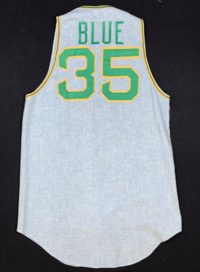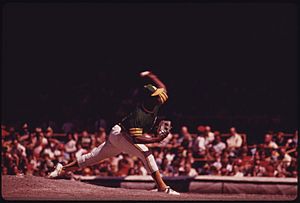Vida Blue facts for kids
Quick facts for kids Vida Blue |
|||
|---|---|---|---|

Blue in 2010
|
|||
| Pitcher | |||
| Born: July 28, 1949 Mansfield, Louisiana, U.S. |
|||
| Died: May 6, 2023 (aged 73) Tracy, California, U.S. |
|||
|
|||
| debut | |||
| July 20, 1969, for the Oakland Athletics | |||
| Last appearance | |||
| October 2, 1986, for the San Francisco Giants | |||
| MLB statistics | |||
| Win–loss record | 209–161 | ||
| Earned run average | 3.27 | ||
| Strikeouts | 2,175 | ||
| Teams | |||
|
|||
| Career highlights and awards | |||
|
|||
Vida Rochelle Blue Jr. (born July 28, 1949 – died May 6, 2023) was an American professional baseball player. He was a left-handed pitcher in Major League Baseball from 1969 to 1986. He was a key player for the Oakland Athletics team that won three World Series championships in a row from 1972 to 1974. In 1971, he won the American League (AL) Cy Young Award and the Most Valuable Player Award.
Vida Blue was a six-time All-Star. He was one of only five pitchers in baseball history to start the All-Star Game for both the American League (in 1971) and the National League (in 1978). During his 17-year career, he played for the Oakland Athletics (1969–1977), San Francisco Giants (1978–1981; 1985–86), and Kansas City Royals (1982–83).
Contents
Early Life and Baseball Beginnings
Vida Blue was born and grew up in Mansfield, Louisiana. He was the oldest of six children. His father worked in an iron foundry.
Blue went to DeSoto High School in Mansfield. He was a pitcher for the baseball team and the quarterback for the football team. In his last year of high school football, he threw for 3,400 yards and 35 touchdowns. He also ran for 1,600 yards. In his last year of high school baseball, Blue threw a no-hitter with 21 strikeouts in just seven innings.
Vida Blue's Pitching Style
Blue was a strong pitcher who worked quickly. He threw his pitches right into the strike zone. He sometimes threw a curveball to trick hitters and had a good change-up. His best pitch was a fastball that usually went 94 miles per hour, but could reach 100 miles per hour.
Pete Rose, a famous baseball player, said that Blue "threw as hard as anyone" he ever faced. Baseball expert Bill James called Blue the hardest-throwing left-handed pitcher of his time. He was also the second hardest-throwing pitcher overall, after Nolan Ryan.
Major League Baseball Career
Joining the Oakland Athletics (1969–1977)
The Kansas City Athletics chose Blue in the second round of the 1967 MLB draft. Even though he could have played college football for big universities like University of Notre Dame, Blue decided to sign with the Athletics. He signed for $12,500 a year to help his family after his father passed away.
Blue started the 1969 season in the minor leagues. He made his first major league appearance on July 20, 1969. In 1970, after playing more in the minor leagues, Blue was called up in September. He made two starts. On September 11, he pitched a shutout against the Kansas City Royals, giving up only one hit. Ten days later, Blue threw a no-hitter against the Minnesota Twins. He was one of the youngest pitchers ever to throw a no-hitter.
Amazing 1971 Season and World Series Wins
In 1971, Blue had an amazing record of 24 wins and 8 losses. He led the American League with a 1.82 ERA and eight shutouts. He also struck out 301 batters. For his incredible performance, he won both the Cy Young Award and the American League Most Valuable Player Award. He also led the league in complete games (24) and shutouts (8).
That season, the Athletics won the American League West title. This was the team's first time in the postseason since 1931. Blue started the 1971 season very well, winning 10 of his first 11 games. He was the youngest American League player to win the MVP Award in the 20th century. He was also the starting pitcher for the American League in the 1971 All-Star Game. In 1971, Blue was featured on the covers of Sports Illustrated and Time magazine.
After his great 1971 season, Blue and the Athletics' owner, Charlie Finley, had disagreements about his pay. Blue had earned $14,000 in 1971 and wanted $92,500. He missed part of the 1972 season before they agreed on $63,000. Blue finished 1972 with a 6–10 record. He mostly pitched as a relief pitcher in the postseason. In the 1972 World Series against the Cincinnati Reds, he appeared in four games.
Blue continued to be a key player for the Athletics. He had 20 wins in 1973, 17 wins in 1974, and 22 wins in 1975. The Athletics won five straight American League Western Division titles from 1971 to 1975. They also won three World Series championships in a row in 1972, 1973, and 1974.
One of his best postseason games was in 1974. He pitched a complete-game 1–0 shutout against the Baltimore Orioles in Game 3 of the ALCS. On September 28, 1975, Blue, Glenn Abbott, Paul Lindblad, and Rollie Fingers teamed up to throw a combined no-hitter against the California Angels.
After the 1976 season, many of the Athletics' star players left the team. This was due to new rules about players being able to choose where they play. Blue, who was still under contract, stayed with the team. He helped guide a new team of mostly young players.
Playing for the San Francisco Giants (1978–1981)
In March 1978, the Athletics traded Blue to the San Francisco Giants. In 1978, Blue had 18 wins and 10 losses with a 2.79 ERA. He helped the Giants win 89 games and finish third in their division. He also started for the National League in the 1978 All-Star Game. He won the Sporting News National League Pitcher of the Year award.
Blue continued to pitch for the Giants. He had 14 wins in 1979 and 14 wins again in 1980. In 1981, a season shortened by a strike, he had 8 wins.
Time with the Kansas City Royals (1982–1983)
The Giants traded Blue to the Kansas City Royals on March 30, 1982. He had 13 wins and 12 losses in 1982. In 1983, Blue had 0 wins and 5 losses. He was released by the Royals in August 1983.
Return to the San Francisco Giants (1985–1986)
In April 1985, Blue returned to the San Francisco Giants. He signed a one-year contract. He had 8 wins and 8 losses in 1985.
Blue signed another one-year deal in 1986. He finished his career with 10 wins and 10 losses at the age of 36. On April 20, 1986, he won his 200th career Major League Baseball game. Blue signed with the Oakland Athletics for the 1987 season, but he announced his retirement in February 1987.
After Baseball
After his baseball career, Vida Blue worked as a baseball analyst for NBC Sports Bay Area. This is the TV home of the San Francisco Giants.
Charity Work
In 1971, Blue joined Bob Hope on his USO Christmas tour. They visited military bases in Vietnam and other places. Blue stayed active in charity work. He supported causes like Safeway All Stars Challenge Sports, car donations, celebrity golf tournaments, and charities for children.
Blue also helped promote baseball in Costa Rica.
Personal Life
In September 1989, Blue married Peggy Shannon on the pitcher's mound at Candlestick Park. His former teammate Willie McCovey was his best man. Orlando Cepeda walked Shannon to the mound.
They had twin girls and later divorced. Vida Blue also had a son named Derrick and two other daughters.
After retiring from baseball, Blue lived in California's Twain Harte area for many years. Later, he moved to Tracy, California.
Vida Blue passed away in a hospital on May 6, 2023, at the age of 73. Team officials said he died due to health problems from cancer.
Images for kids




